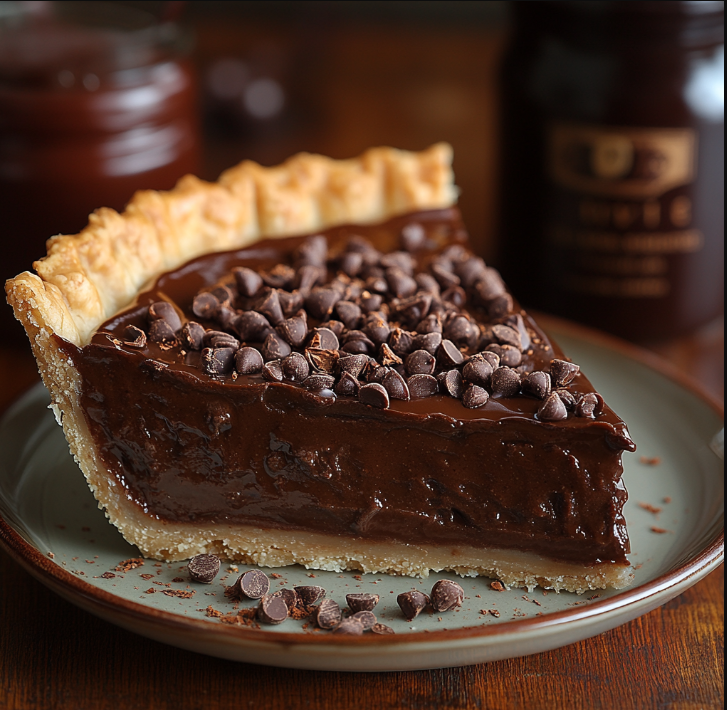A watery chocolate pie can be a frustrating outcome after spending time making a decadent dessert. While a well-made chocolate pie should have a smooth, thick filling, several factors can cause it to turn runny. In this article, we’ll cover the main reasons why your chocolate pie might be getting watery and how to prevent it in the future.
What Causes Chocolate Pie to Get Watery?
Various factors can result in a watery chocolate pie. These range from undercooking to improper ingredient measurements.
Undercooked Filling
One of the primary reasons for a chocolate pie to become watery is undercooking. If the filling doesn’t reach the right temperature, it won’t set correctly, leaving a runny texture. To avoid this, ensure you cook your filling long enough until it reaches a pudding-like consistency before removing it from heat.
Too Much Liquid in the Recipe
An excess of liquid, such as milk or cream, can upset the filling’s balance, causing it to remain watery. It’s crucial to measure your ingredients accurately. If you’re interested in how to thicken pie fillings, you might also enjoy this detailed article on how to thicken coconut cream pie filling, which shares valuable tips applicable to any pie.

Incorrect Baking Temperature
Another common issue is incorrect baking temperature. Baking at too low of a temperature will not allow the filling to set, while too high of a temperature might cause the filling to boil over. For the best results, always use an oven thermometer to ensure you’re baking at the proper temperature. You can learn more by exploring recipes like the one for a coconut cream pie, which has specific baking tips that might be useful.
The Role of Starch and Thickeners in Chocolate Pie
Using starch or thickeners like cornstarch can make all the difference when trying to achieve the perfect pie filling consistency.
How Cornstarch Stabilizes the Filling
Cornstarch is one of the most commonly used thickeners in pie fillings. It helps bind liquids and firm up the filling as it cools. If you don’t use enough cornstarch, the filling may stay loose, but too much can result in a gummy texture.
Alternatives to Cornstarch
If you want to try other thickening agents, consider using arrowroot or tapioca flour. These alternatives can work well for a variety of fillings. For best results, make sure to adjust the measurements properly based on the substitute you choose.
Common Mistakes with Thickeners
One mistake many make is adding the thickening agent directly into the hot filling, which can lead to clumping. Instead, always mix the cornstarch with a bit of cold water before incorporating it into the heated mixture for a smoother result.
Baking and Temperature Tips to Prevent a Watery Chocolate Pie
Temperature control during the baking process is essential to ensuring your chocolate pie doesn’t turn watery.
Preheating the Oven
It’s important to preheat the oven fully before placing your pie inside. A cold or inconsistent oven temperature can cause the pie to cook unevenly, which might result in a runny filling. You can explore more tips on baking pies in recipes like this one for a chocolate pie.
Baking on the Lower Rack
For liquid-based fillings, it’s recommended to bake your pie on the lower rack of the oven. This positioning allows for even heat distribution and ensures that the filling cooks through properly while avoiding overbaking the crust.
Using a Pie Shield
If you’re worried about your crust burning while the filling sets, consider using a pie shield. This tool helps protect the edges of the crust while ensuring that the filling has time to cook evenly without browning too quickly.
How to Properly Cool and Store Chocolate Pie
Proper cooling and storage techniques are crucial to preventing your chocolate pie from becoming watery after baking.
Cooling Time
Once your pie is baked, let it cool completely at room temperature. Avoid rushing the process by refrigerating it too soon, as this can cause condensation to form, which makes the pie watery.
Storing in the Fridge
After cooling at room temperature, store your pie in the fridge to allow the filling to set fully. Cover the pie with plastic wrap or place it in a sealed container to prevent moisture from building up. For more pie storage tips, check out this guide on why pies get watery, which includes useful information on how to avoid this problem.
Avoiding Condensation
Condensation is a common issue when refrigerating pies. If you notice moisture forming on the surface, gently dab it with a paper towel before serving.

The Impact of Overmixing and Overbaking on Pie Texture
While undercooking leads to a watery texture, overmixing and overbaking can also impact the consistency of your pie.
Why Overmixing Ingredients Causes Issues
When you overmix the ingredients, especially eggs, you introduce too much air into the filling. This can cause the filling to separate or become runny. To avoid this, mix the ingredients just until combined and no longer.
Signs of Overbaking
Overbaking can cause the filling to break down and release moisture, making it watery. Look for cracks or bubbling on the surface, and remove the pie from the oven once the filling has set but is still slightly jiggly in the center.
Adjusting Bake Times Based on Pie Types
Not all pies require the same baking times. For example, mousse pies need less time than custard-based pies. Adjust your bake times accordingly, based on the specific pie recipe you’re using.
FAQs: Why Is My Chocolate Pie Watery?
Why does my chocolate pie not set?
If your pie doesn’t set, it’s likely because the filling wasn’t cooked long enough or the proper ratio of thickeners wasn’t used.
How do I avoid watery filling?
Ensure that you’re using the correct thickening agents, cooking for the right amount of time, and allowing the pie to cool fully before refrigerating or serving.
Can I fix a watery chocolate pie?
Once baked, fixing a watery pie can be challenging, but you can try refrigerating it longer to help it firm up.
Conclusion
A watery chocolate pie can be disappointing, but understanding the causes and implementing the correct techniques will help you avoid this issue in the future. Paying attention to ingredient ratios, cooking time, and cooling methods can ensure your pie comes out smooth and creamy every time. For more delicious pie recipes, you can also explore this lemon cream cheese pie, which offers another take on classic, rich desserts.

